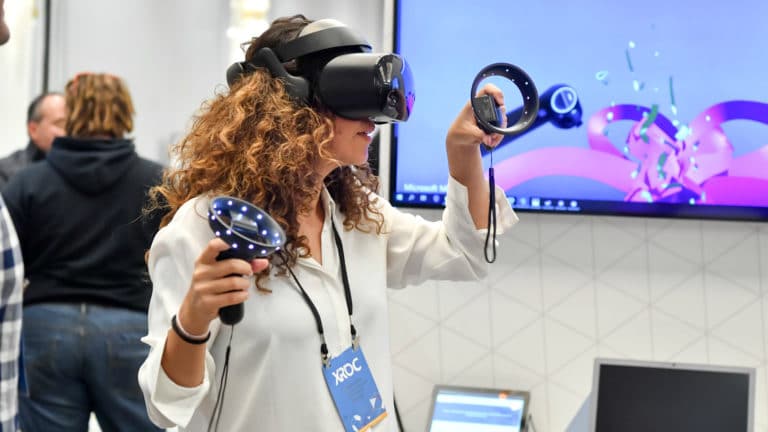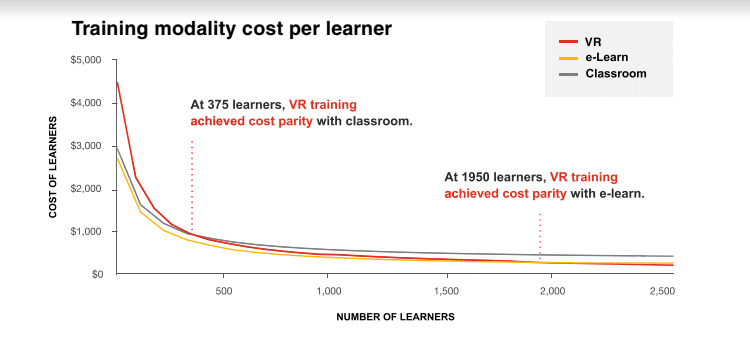
One of the branches of VR that sees the most attention and investment from enterprises is training. The thought is that VR’s immersive qualities can instill greater knowledge retention and memory encoding. It continues to outperform legacy approaches such as print manuals.
Support for this memory-retention comes from a study by Zappar and Mindshare UK. It worked with AR but the concept is the same, given immersive 3D learning. It found that content delivered in this format produced greater memory retention than a control group.
This principle has led to growing investment in VR training in industrial and corporate settings. For example, Bank of America just launched a program across 4,000 branches. VR training innovators such as Strivr meanwhile continue to expand into new verticals and use cases.
But what other signals validate VR’s efficacy as a training tool? As we do in several spatial sub-segments, we’re perpetually collecting and indexing VR training proof points, which have now reached critical mass. So we’re rolling them out, all at once for this week’s Data Dive.
Proof Points
Diving right in, here’s our collection of data points that speak to VR’s effectiveness in enterprise training across a variety of use cases.
Retail, Corporate & Service
— In Walmart’s retail employee VR training (via Strivr), VR was shown to reduce training time from 8 hours to 15 minutes with no drop in efficacy. It also boosted test scores 10-15 percent and increased employee confidence metrics and retention.
— Verizon implemented VR training for call-center reps to de-escalate upset customer calls. It increased consistency and effectiveness and reduced training time from 10 hours per-person to 30 minutes.
— Grain storage company GSI’s immersive 3D training for field workers reduced installation time for new grain systems by 60 percent.
— A PwC study of 1600 knowledge workers concluded that VR can reduce training time for employee soft skills 4x versus classroom or online training. VR-trained individuals were also 340 percent more confident in their new skills, and 4x more emotionally connected to the content.

Medical Training
— Microsoft AR visionary and Hololens lead Alex Kipman reports that in a recent study, HoloLens2 helped Case Western Reserve medical students score 50 percent better while learning faster and retaining knowledge more comprehensively.
— NHS and Virti studied the effects of VR training for medical professionals and found that 92 percent of trainees adequately understood training materials versus 16 percent for a control group. Post-training performance also grew 230 percent for the VR group versus 17 percent for the control group.
— Through the use of VR training in 20 teaching hospitals across 20 countries, Surgeons training with Osso VR showed a 230 percent improvement in surgical performance.
Cost Savings
— PwC estimates that organizations can spend about $195 per employee in knowledge-worker training with VR, versus up to $265 for traditional methods.
— Virti has calculated based on VR training’s time-savings and productivity gains in medical contexts, that organizations can save an average of $2,800 per VR-trained practitioner per year.
— Nestlé Purina Petcare saved more than $100,000 on travel and lost productivity by implementing VR training in place of onsite training seminars.
Milestones & Market Sizing
— VR training platform Interplay reports that its usage grew 445 percent in 2020, now standing at 2,000 companies and 15,000 monthly users.
— Lastly, a PwC report last year predicted that 23.5 million global jobs will deploy AR and VR for training by 2030.
Business Case
One thing that jumps out from these data points is the variety of use cases and verticals. VR training is being applied to everything from medicine to retail to grain storage. This demonstrates its breadth of applicability as a horizontal technology, which in turn speaks to its market size.
VR training will expand deeper into these verticals as its efficacy continues to be validated and its ROI story resonates with enterprise execs. This process will take a while — as emerging tech assimilation often does — but the clear benefits and business case will help accelerate things.
Another accelerant is Covid-era dynamics. The value that VR adds to training is evident in normal times. But it takes on new meaning during Covid-era lockdowns when distanced interactions are the name of the game. VR training is inherently distanced as it simulates real-life scenarios.
That dynamic is clear, but it’s unclear what will happen next. Will the tools discovered during this period create permanent habits through a “mere exposure effect?” If so, it could bode well for VR’s sustained use in a post-Covid world, and its continued rise as a training utility.

